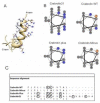Structural and Functional Characterization of the Newly Designed Antimicrobial Peptide Crabrolin21
- PMID: 36984752
- PMCID: PMC10053045
- DOI: 10.3390/membranes13030365
Structural and Functional Characterization of the Newly Designed Antimicrobial Peptide Crabrolin21
Abstract
(1) Background: antimicrobial resistance is becoming a dramatic problem for public health, and the design of new antimicrobial agents is an active research area. (2) Methods: based on our previous work, we designed an improved version of the crabrolin peptide and characterized its functional and structural properties with a wide range of techniques. (3) Results: the newly designed peptide, crabrolin21, is much more active than the previous ones and shows specific selectivity towards bacterial cells. (4) Conclusions: crabrolin21 shows interesting properties and deserves further studies.
Keywords: CD spectroscopy; NMR spectroscopy; antimicrobial resistance; membrane specificity.
Conflict of interest statement
The authors declare no conflict of interest.
Figures






References
Grants and funding
LinkOut - more resources
Full Text Sources
Molecular Biology Databases

